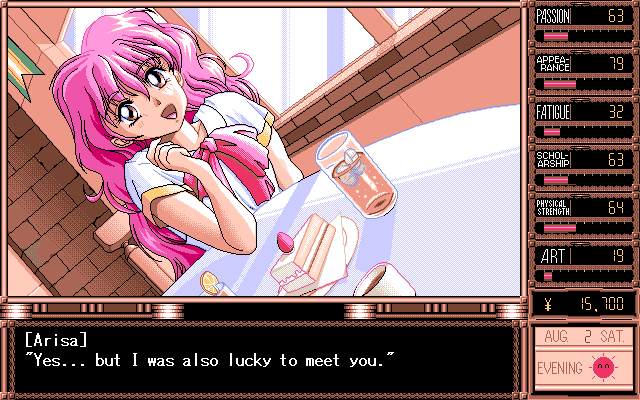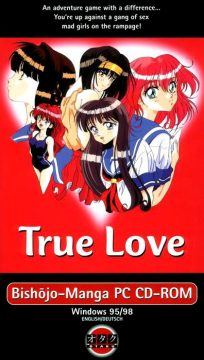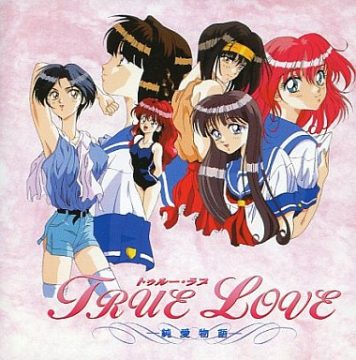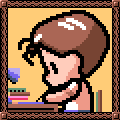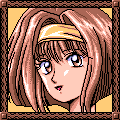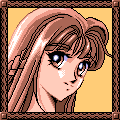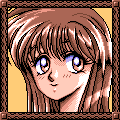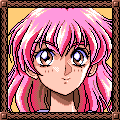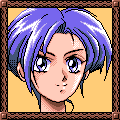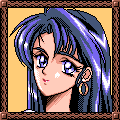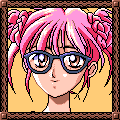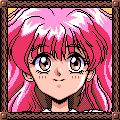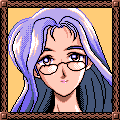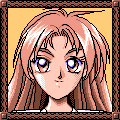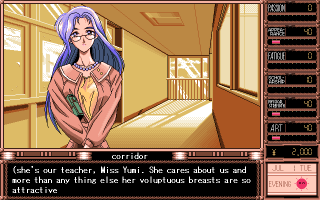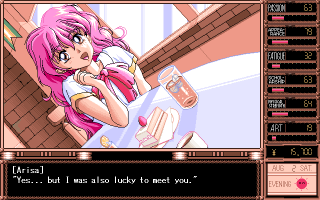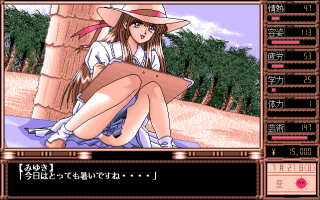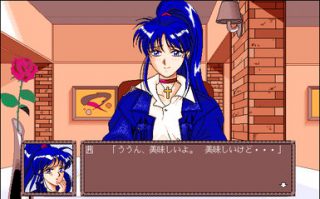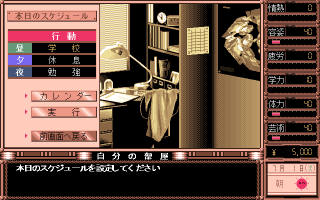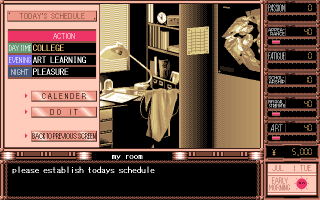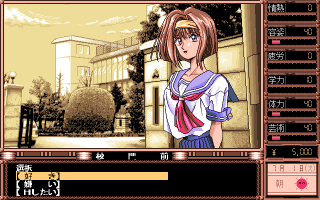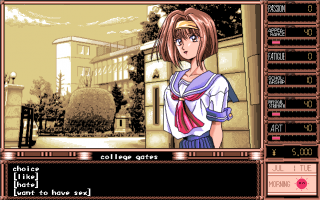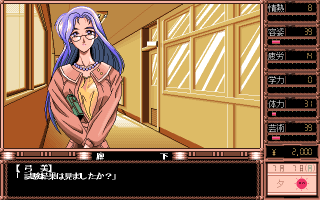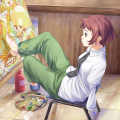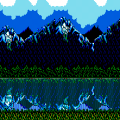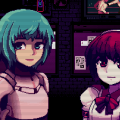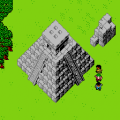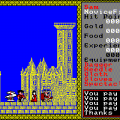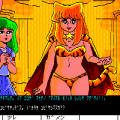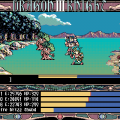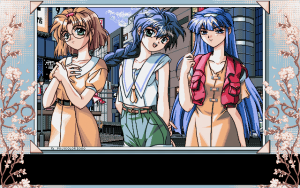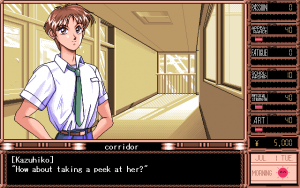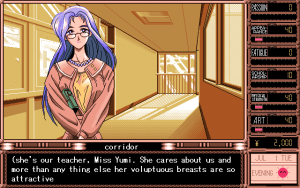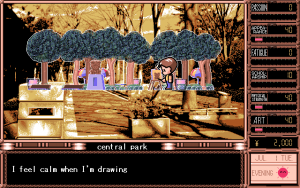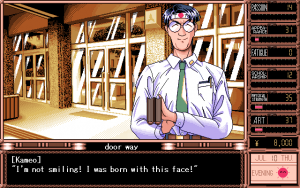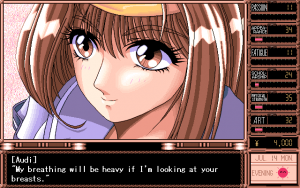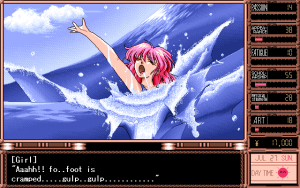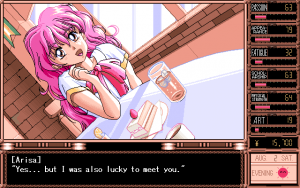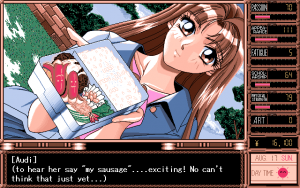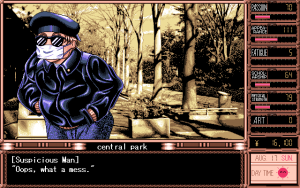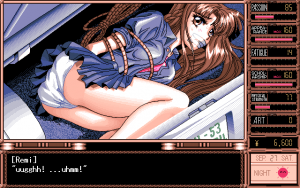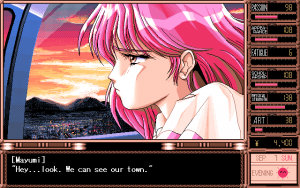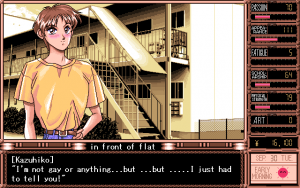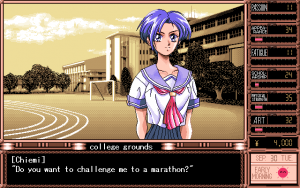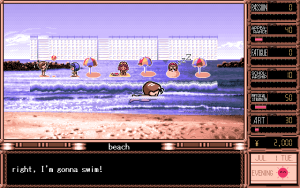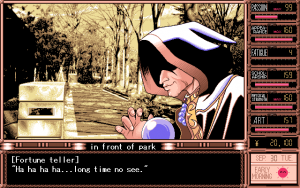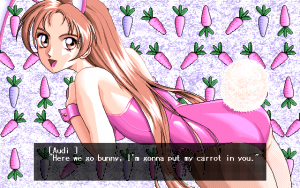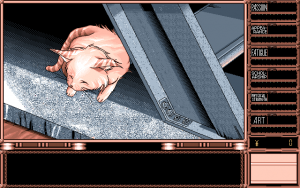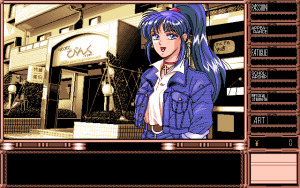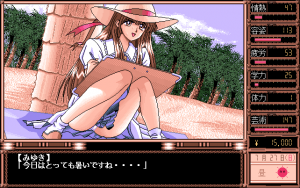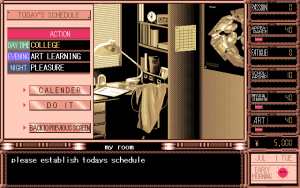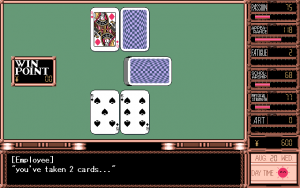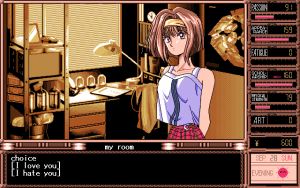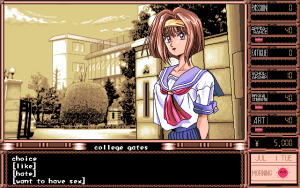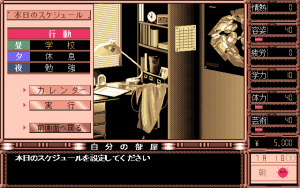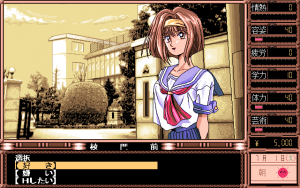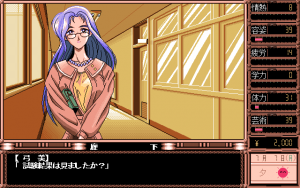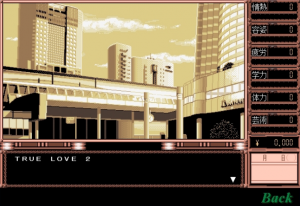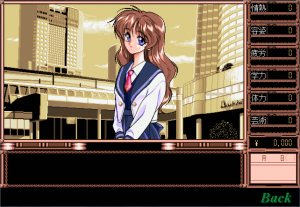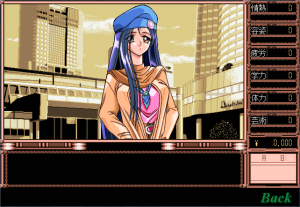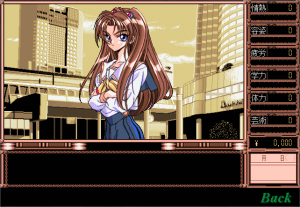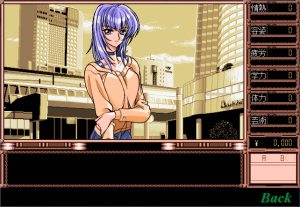Do you remember your very first love? Was it that pretty girl next door that captured your heart from an early age? Or maybe that cute shy girl in your art class in high school? Maybe it was even your art teacher who you just happened to stumble in on while she was being molested and who rewarded you with a night of intimacy for saving her? Or maybe, just maybe, it was your cat who just happened to transform into a well-endowed beauty who had been put under a spell, and through your care and attachment as a pet owner had become naturally interested in coitus? Well, if you are the main character of True Love, all of the above may be the answer to that question.
True Love is an adult bishoujo (dating sim) game released by Software House Parsley, a small software developer who entered the industry 1989 with a game on PC-98 called Celery, with the objective being to combat a tornado made up of women’s clothing. Parsley achieved some minor success on the PC-98 and X68000 with their library of mediocre products and production values. In particular, the game VENUS gained some attention and saw a re-release with added voice acting after its release in 1994. True Love was Parsley’s 14th release, hitting shelves on June 9th, 1995. Reception in Japan was, as with most other Parsley titles before it, cited as unimpressive and easily forgettable.
In the US however, things turned out a bit differently. Ever since pornography shot into the mainstream’s eye in the 1970s, the adult industry suddenly enjoyed an all-new acceptance from a younger generation that didn’t blush at the sight of buttocks gyrating for minutes at a time. Alongside the rise of adult entertainment acceptance, home entertainment was also becoming common in the average household. Video home systems and video game consoles not only allowed for families to enjoy the latest all-American feel-good story from the comfort of their own couches, but also for discreet and private viewing of adult material.
But for the most part, the depiction of sex in Western video games and print media was, more often than not, crude and embarrassing. Games and comics were considered childish pastime activities, a stigma they still somewhat retain today, and as such the development of adult games was behind closed doors while sales were under the desk. These early attempts didn’t do much to help the view of conservative minds as they revolved around either violating a woman tied to a cactus or drinking unicorn milk dropped from a rooftop. Things didn’t really progress much over time, with nudity being mostly attached to strip poker games tied to the license of models and adult actresses, and with the introduction of CD-ROM and video playback, adult games took the shape of simple scene editors where you simply chose the actions on screen. Despite their less than stellar user interfaces and pointless objectives, these games were still considerably better than Marky Mark and the Funky Bunch: Make My Video.
Japan’s general social acceptance and curiosity of sex allowed for a more healthy use of adult situations in manga, animation and video games. In the West, the majority of consumers associated games and cartoons with Super Mario and Disney, and it was hard to imagine Ariel actually getting rid of those seashells and letting Prince Eric rub her gills. This would change for some with the introduction of anime in the late 80s, showcasing deep storylines with serious situations, violence, and sex often being the selling points. Titles like Vampire Hunter D and Akira, though not featuring adult content, showed there was an audience that was very interested in mature-angled animation, and with the release of Urotsukidoji, it was all the more clear that this audience also welcomed the addition of explicit sex scenes. Throughout the 90s, independent publishers took notice and started localizing Japanese adult games. These games would range from all genres of RPG to card games, but mostly it was the visual novels that proved easiest to translate, and also most popular with the players. An added selling point was that, when localized, these games would be outside of Japan’s strict censorship laws and be completely uncensored for the Western audience to enjoy. The very first “hentai” game to be officially published in English was Inos’s Cobra Mission, released in 1992 by Mega-Tech, with a short list of titles trickling out in its wake. In 1998, Otaku Publishing released True Love in English.
True Love revolves around the daily life of Daisuke, a student who studies at the nearby university. Summer is approaching and exams are near, leaving him stressed and worried. To make matters worse, he doesn’t have a girlfriend and his father is hot on his neck to find someone to share his life with. Daisuke is kicked out of his parents’ house and forced to live in his small apartment in hopes that life in solitude will ignite the fire in him and speed up the process of finding a life partner. As the game starts, the player is given the choice of choosing the personality type for Daisuke and quickly thereafter, the cast of girls is introduced over the first few days in the game:
Cast
Name: Daisuke (MOBY)
Age: 19
The main character. He is a procrastinating young man who is at a crossroad in his life, trying to figure out what direction he wants to go academically. On top of this, he is also looking for a girlfriend. He lives on his own after being kicked out by his own father. His name is a play on words of the Japanese term “dai suki”, which means “I love you”.
Name: Mikae Morikawa
Age: 18
Daisuke’s childhood friend. She has always been something of a tomboy, but as Daisuke gets closer to her, he realizes she has very feminine qualities. She has no overall preferences.
Name: Remi Himekawa
Age: 18
The smartest girl in school. She is the daughter of a high-standing business man and has a very sophisticated nature. She spends most her time studying at school and the library. Her preference is intelligence.
Name: Miyuki Tanaka
Age: 18
An art student at the school and very shy. She suffers from anemia. Despite being somewhat reserved, she is very caring and warm. Her preference is art.
Name: Mayumi Kamijo
Age: 18
A fiery red head that Daisuke meets at school. She is very direct and aggressive. For some reason, she seems to always hang out around the love hotels downtown. Her preference is good physical condition.
Name: Chiemi Fujimoto
Age: 18
Chiemi is the captain of the school’s swimming team and highly athletic. Her competitiveness and strength makes her rather fearless, but she has a deadly fear of caterpillars. Her preference is good physical condition.
Name: Misako Sayama
Age: 24
A seductive and mysterious lady that Daisuke meets at the streets during nighttime. She is later revealed to be the substitute nurse at Daisuke’s school. Her preference is good physical condition.
Name: Ryoko Shimazaki
Age: 18
A transfer student that joins class halfway through. Even though she is an all-new student, there is something very familiar about her behind her large glasses. Her preference is intelligence.
Name: Arisa Miyoshi
Age: 18
The little sister of Daisuke’s best friend, Kazuhiko. She might look very young but she is only one year younger than Daisuke and her brother. She is not a very good swimmer but loves to be in the water. She also loves video games. She has no general preference.
Name: Yumi Matsumiya
Age: 25
Daisuke’s teacher and counselor. She cares deeply for Daisuke and makes sure he does all his homework and studies to ensure he keeps his grades up. She is the oldest woman in the cast. Her preference is intelligence.
All these girls branch off into their own storylines depending on who the player decides to focus his attention on. As with most visual novels, the game is played through a linear set path which is told through text and illustrations on screen. At certain times, players get the choice between a selection of actions, often related to where to go or how to answer a certain character. But there is one thing that sets this game apart from many of its contemporaries – the stats system.
The game plays on a day-by-day basis with players having to schedule out the day. Per day, you have three action slots to fill out, though during school days, the day time slot will be College with no choice of skipping school. At your disposal you have Sports, Art Learning, Study, Break, Fashion, Shopping, Pleasure, and Work. All these choices affect Daisuke’s stats. The events of the game and the characters all relate to you based on these stats, similar to how stats in RPG games work. To make things more interesting, these different actions will all affect one another, leading players to put some thought and strategy into their schedules. Sports will improve your appearance and physical condition, but will affect your fatigue and scholarship, while studying will raise the scholarship stat while decreasing the physical condition and appearance stats. Therefore, the player needs to find a balance to things and figure out the best weekly schedule to improve the desired stats. As mentioned before, at the beginning of the game you are given a choice of what kind of personality Daisuke has. This choice doesn’t affect his behavior in the game, but rather affects the scheduling and starting stats. Players must also be cautious of the Fatigue stats, as it will cause you to collapse and lose several days’ worth of character building.
Every day has three parts and depending on what choices are made in the schedule, certain events are triggered if Daisuke finds himself at the right place at the right time. This leads to an interesting mix of preset events along with events based on luck which affect your chances with some characters. Apart from the weekends, the first part of the day will be set for college, which follows a linear path of events and story. Most of the girls are introduced in the school part of the game, so naturally the choices you make gravitate towards the interests and preferences of the girl you take an interest in. There are still certain events that require some specific scheduling, adding to the replay value of the game.
Money is a minor factor in the game, though in certain storyline branches, it finds a bigger importance in order for the player to achieve success with the desired girl. The way money is earned is through Daisuke’s part time job at the local construction company. This is one of the options one can choose from in the daily schedule, but work has the most negative effect on the stats of all the options, filling up the Fatigue gauge at an alarming rate. Money can always be spent on various shops where you can purchase potions and items which raises specific stats, or special items which are used to further storylines along the way. It is rarely necessary to rely on any of the benefit items, however, so money becomes an afterthought rather quickly, especially with the unbalanced negatives attached to it.
Another way to earn a few bucks is either through lottery or gambling. While lottery is simply done by purchasing a ticket and waiting for the last day of the month to roll by, the gambling feature allows you to play a round of blackjack. The rules are simple: place your bet and get closest to 21. Sadly, like Vegas, this feature is rigged beyond belief, and there is little chance of winning as the computer deals you terrible cards time after time. Making matters worse, if you were to win once in a blue moon, the prize money just simply wouldn’t make up for the 1000 losses before it. Blackjack is entirely optional, however, and never plays into the storyline, so luckily it can be ignored.
Being a focused individual does offer more benefits than simply getting lucky with busty babes and purring cats. Once you have focused and maintained a schedule leaning towards a certain skill or interest, a corresponding God will appear in your dreams and gift you with a substantial boost in the stats which you have focused on. This creates a somewhat unbalanced element to the game since the boost is so generous, it is easy to shift direction and fill up completely unrelated stats after it and become near maxed out on all stats, though the Fatigue meter makes it impossible to become completely maxed out on every one in time. Each God can only appear once during a given play through, and after each visit, they also drain the Fatigue meter to zero.
The writing is what truly made the game stand out when released. When independent publishers started slowly releasing eroge games in the US, they went for smaller titles for the most part, in both popularity and size of the game itself. Cobra Mission, despite introducing the genre to the West, was riddled with horrible writing which completely crippled any story in becoming effective. Other titles such as Knights of Xentar suffered the same problem, while other games were often very simple, requiring little thought to become enjoyable. It was the releases of Nocturnal Illusions in 1997 and, one year later, True Love that managed to showcase fully functional storylines from start to finish which featured sex. While the original Japanese dialogue and structure was light-hearted, the translation takes a lot of liberties and makes nearly all situations tongue in cheek, never taking itself very seriously at all. The story can go into almost every category, from slapstick to suspense and even the supernatural. That’s why sometimes the writing can become somewhat out of place, with the game trying to tell you something serious is happening while the dialogue remains fairly silly. Each character is handled with care, however, and manages to display her character well through her dialogue. True Love also pokes fun at other contemporary games, with Daisuke and his friend Kazuhiko often discussing the most popular game on the market, Final Oxymoron VII. Despite being relatively well localized, grammatical errors and confusing wording does appear more frequently than in the usual mainstream game, and some sentences seem to suffer from a character limit in the text window.
Each girl represents a different genre, following the usual lineup found in eroge games like teenage romance to kidnappings and dating your best friend’s underage-looking little sister. But sex isn’t as prevalent in this game as one might think going into it. Indeed, the humor and situations are often filled with sexual innuendo or heated situations, but sex itself only comes into play at the very tail end of the game when your focus is solely on one girl and it’s time to consummate your newfound love life. Very few characters of choice have more than a single sex scene, and the scenes are relatively tame and short compared to even the earliest of titles brought over to the US. This might have been why the game found success in the West, as it actually gave gamers a real chance to care and understand the characters they gravitated towards instead of just constantly clicking past the 100 or so penis metaphors the translators could come up with. As usual with these types of games, the scenes which the player goes through can be viewed again in a gallery mode after each play through. Even though he becomes a choice for the player to hook up with, Kazuhiko does not get any illustrated action, which apparently resulted in some complaints from homosexual gamers who felt the game should have equally shown what became of Daisuke and Kazuhiko once out of the closet. The Japanese release does not feature any additional story or illustration during this ending.
While the story might have been better than expected for an American audience, the game suffers from very obvious low production values. The character design and illustrations were all done by TD-X, an employee of Parsley since the very beginning. While his backgrounds and event illustrations can at times be very attractive, the character illustrations during dialogues look crude and disproportionate. The music is probably more offensive than some of the sex acts found within the game, and becomes extremely tedious with short looping points and overall boring compositions which don’t really fit the characters or the situations they are played within all that well. The Windows version also features several bugs in the save system which sometimes render saves completely useless, requiring the player to start over again. Graphically there is no difference between the PC-98 and Windows version, though musically, the game sounds much better on the PC-98 due to the choice of sound engine.
Upon release, the game did not receive the warm welcome in Japan that it eventually did in America. By 1995, its original release year, titles such as Rance, Viper and Dragon Knight had substantially better production qualities and could at times rival not only the artwork and music of mainstream console games, but also the stories of the most popular of RPGs available at the time. True Love was seen as nothing more than a Tokimeki Memorial spoof and would go relatively unnoticed on the market. For Westerners, it became one of the essential visual novel titles and the first entry point into the whole genre of dating sims. From the success of True Love, more titles started coming out with deeper storylines and darker content, often through the efforts of JAST USA, the eroge/bishoujo publishing company owned by Peter Payne of J-List fame.
At one point in the game, Daisuke stumbles upon a mysterious girl outside the love hotel. While the girl doesn’t say that much and only appears once throughout the entire game, she drains the Fatigue meter and seems to be hinted as being part of bigger things. This is in fact a cameo of Akane from Parsley’s more successful game, VENUS. Due to VENUS never seeing an overseas release, this cameo goes over the heads of most players and serves as more confusing than it is interesting. The scene does not serve much purpose and could have been cut, but it is unknown if Otaku ever had plans for bringing VENUS over and therefore did not elaborate more on her character intentionally to keep interest in her future appearance.
Sequel rumors and misinformation
Due to its success, the demand for a sequel was quite high for True Love. When the game had its initial release, the bishoujo market was extremely young in the West and information was hard to come by, and more often than not, the information was also wrong. This led to quite a few different rumors of sequels being available. In reality, True Lovenever had any sequel.
Seasons of Sakura was often cited as a sequel even though it was produced by a separate company and even released one year prior. This title shares similarities in tone, which is often the case as these games never stray far from their structures.
Another popular rumor was that True Love had a speech version only released in Japan. It was quite normal for companies to issue a voiced version of their text-based games if they enjoyed good sales. Parsley released such an upgrade for VENUS in 1996, but True Love never received such an upgrade. On PlayStation, ASCII released True Love Story in 1996, an unrelated dating sim about high school romances. True Love Story would go on to have three sequels across PSX and PS2. These are often mistaken for sequels to True Love as well.
The main instigation of these rumors came from a rare demo release titled True Love Select. Parsley would release Select versions of the majority of their games which added new characters. In addition to the four girls that the demo previews, there is also a small blurb which says True Love 2. It’s hard to say if these was meant to tease a sequel or if simply the demo refers to itself as True Love 2, but the official Parsley web site makes no mention of any True Love 2 ever having been planned. Parsley still remains active, though several members went on to form another eroge company called U-Me SOFT.
